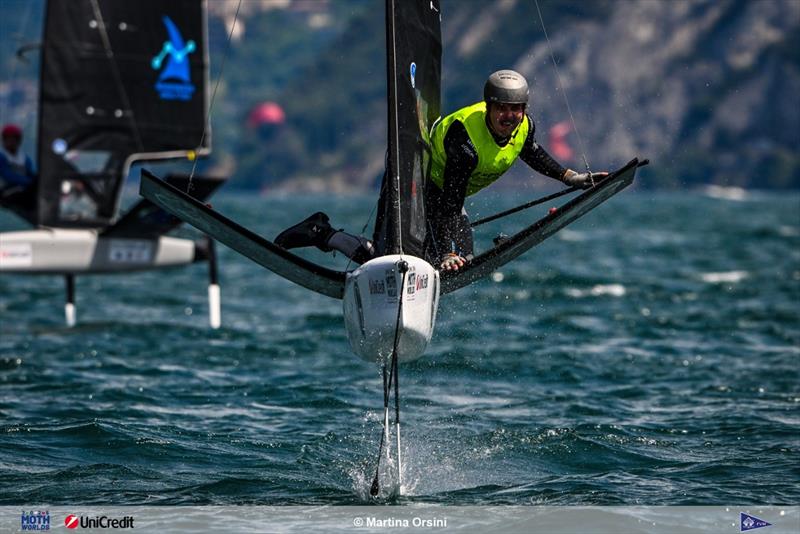
Mackay Bieker BM-V3 dominates at 2025 Moth Worlds on Lake Garda
by Julia Faire/Mackay Boats 17 Jul 2025 01:07 AEST

Enzo Balanger (FRA) - 2025 World Champion - International Moth Class - Lake Garda, Italy - July 2025 © Martina Orsini
The 2025 Moth World Championships in Lake Garda delivered thrilling racing across a wide range of conditions, featuring an elite lineup of Olympic champions, America's Cup helmsmen, SailGP stars, and the next group of up-and-coming youth.
America’s Cup Youth sailor Enzo Balanger claimed the title, with Tom Slingsby and Jake Pye rounding out the podium, with Jake having also finished on the podium at the 2024 Worlds.
Many of these sailors came from the demanding 2024 Worlds in New Zealand, which delivered heavy-air racing at upper limits. That event marked many technological developments in the Class, with innovation on display across nearly every area of the boat.
Among the developments was the Mackay Bieker Moth (BM-V3), built by Mackay Boats. The boat didn’t get its proper debut until the 2024 World Championship, where it made an emphatic statement. Clocking speeds at over 39 knots and sailed by the first 21 of the top sailors, the BM-V3 quickly became the boat to beat.
Despite questions heading into the 2025 World Championships about whether rivals had closed the gap, the Mackay Bieker again proved dominant, with 9 of the top 10 and 17 of the top 20 competitors using a Mackay Bieker at 2025 Worlds.
What Goes with the Mackay Bieker: BM-V3
The BM-V3 emerged from a comprehensive overhaul of the already successful BM-V2 design. The design team focused heavily on reducing drag on the platform, which included minimizing the wings' surface area, optimizing sectional shapes, and lowering friction drag through smarter system designs. The sail landing area was also refined so the sail foot had a perfect seal between the sail and the deck. This required some big tooling changes by Mackay’s Boats.
BM-V3 Wing Deck
At the same time, throughout the year leading up to the 2024 Worlds, nearly all control systems were refined and many were redesigned. In all cases, tolerances in moving parts were reduced and refined, and materials were changed to create more precise and, where possible, simpler linkages in the systems.
Cleat plate, Control lines, Flight systems
Machine shops worldwide were evaluated to identify those capable of producing the most precise parts, and the internal layout was modified to create more direct paths for the lines, reducing friction. Aside from some sheaves, all parts are custom-made to achieve the best possible results.
Foil Innovation
Foil development was a central focus leading into the 2024 Worlds. Sailor feedback spurred continuous refinements, including the addition of steel in the lower half of the main verticals, which significantly reduced drag and increased speed on average by 1 knot.
Interestingly, as speed increases, loads go up, and we quickly discovered other parts of the boat had approached their design limits and needed to be re-engineered and refined. The extreme conditions at the 2024 Worlds also caused sailors to sail for longer periods using high flap angles—something that hadn’t happened before. This prompted Mackay’s to redevelop the flap systems on the main horizontal foils for the 2025 Worlds, which involved extensive research and material testing to find a more robust solution for the flaps.
Steel Rules and Further Refinements
Following the Moth Class's 2025 decision to continue allowing steel foils, Mackay Boats added steel to the rudder verticals, and also introduced a refined main vertical with a longer steel section for the 2025 Worlds. While steel increases weight—a disadvantage in light winds—its drag-reducing benefits at high speeds make it a net performance gain. Mackay’s believes its current steel foil configuration strikes the ideal balance.
Looking Ahead
The success of the BM-V3 foil program has already gone beyond the Moth Class, with Mackay Boats now supplying rudder horizontal foils for SailGP. Much of the manufacturing process will be similar to that used for the Moth foils, but with each new design, new technology options will become available for use on other boats.
This technology, combined with the debrief and feedback from the 2025 Worlds, will help shape the Mackay Bieker’s future developments, with the company committed to exploring retrofitting options where feasible.
Additional Images: